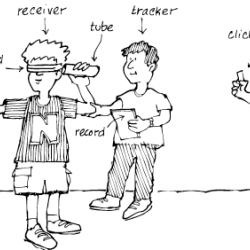Source Institutions
Source Institutions
Add to list Go to activity
Activity link broken? See if it's at the internet archive

This activity (on pages 38-43) has learners simulate the way scientists track and map the movement of otters in the wild using radio trackers. One learner plays the role of Sea Otter, and other pairs of learners play the roles of Receiver and Tracker. The Sea Otter uses a clicker to represent the electronic transmitter on the otter, and each blindfolded Receiver listens through a paper towel tube "antenna" while the Tracker records where their partner hears the loudest click.
- 10 to 30 minutes
- 45 to 60 minutes
- $1 - $5 per group of students
- Ages 8 - 14
- Activity, Model, Simulation
- English, Spanish
Quick Guide
Materials List (per group of students)
- 1 clicker
- Map of North America, including Alaska
- 11 sheets of 8 1/2 x 11-inch white paper to make signs
- 1 empty paper towel tube
- 1 blindfold
Subjects
-
Engineering and Technology
-
Computing
- Information Technology
-
Technology
- Information and Communication
-
Computing
-
Life Sciences
-
Diversity of Life
- Animals
-
Ecology
- Populations
-
Diversity of Life
-
The Nature of Science
-
The Scientific Process
- Gathering Data
-
The Scientific Process
-
The Nature of Technology
-
Technology and Society
- Technology and the Environment
-
Technology and Society
Informal Categories
- Animals
- Physical Activity
Audience
To use this activity, learners need to:
- see
- hear
- be mobile
Learning styles supported:
- Involves teamwork and communication skills
- Involves hands-on or lab activities
Designed specifically for
- Rural dweller
Culture, ethnicity, and gender
-
Girls
- Explicity developed for this group
Other
Foreign language versions of this resource:
Components that are part of this resource:
Includes alignment to state and/or national standards:
This resource is part of:
Access Rights:
- Free access
By:
Source Collection
- Science After School Consumer's Guide
Rights:
- All rights reserved, University of Nebraska State Museum, 2001
Funding Sources:
- National Science Foundation Informal Science Education Program, 9909496
- Howard Hughes Medical Institute
